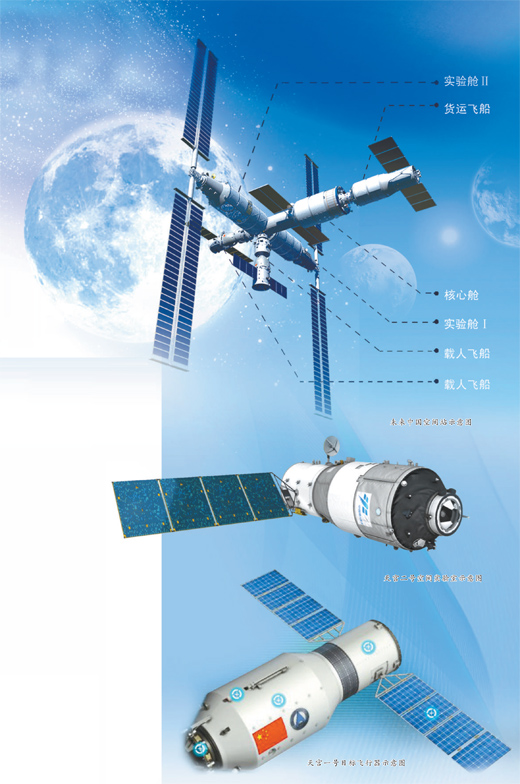

China’s new large carrier rocket Long March-5B rocket made its maiden flight on May 5, sending a trial version of the country’s new-generation manned spaceship and a cargo return capsule into space for testing.
The successful flight marked the start of construction of China’s space station, which is expected to be completed in around 2022. The Tiangong space station, which will orbit 340 to 450 km above the Earth’s surface, is designed to operate for at least 10 years, which could be extended through in-orbit maintenance.

Weighing 66 tons, the station will be T-shaped with the Tianhe core module at the center and a lab capsule on each side, according to Zhou Jianping, chief designer of China’s manned space program.
The core module will be 16.6 meters long with a diameter of 4.2 meters and a takeoff weight of 22.5 tons, and will serve as the management and control center. As China’s largest current spacecraft, it will be able to support a long-term stay for three astronauts in space, as well as scientific experiments.
The living space in the core module is about 50 cubic meters. With the two lab capsules, the living space will be up to 100 cubic meters.
The space station program also includes a space transportation system between Earth and low-earth orbit and a cargo transport system, which will be undertaken by the Long March-2F carrier rockets and Shenzhou manned spaceships, as well as the Tianzhou cargo spacecraft and Long March-7 carrier rockets, respectively.
To allow astronauts to stay longer in orbit, the station will be equipped with a renewable life support system. The hydrogen produced during electrolytic oxygen production and the carbon dioxide exhaled by astronauts can generate oxygen through a chemical reaction, which can supplement the space station’s oxygen supply.
Science facilities on the station will support research projects in fields such as biology, material science, basic physics and microgravity. More than a dozen experiment racks will be installed, and an extra-vehicular experiment platform will be built. In addition, a capsule with a large optical telescope will be flying in the same orbit.
The Chinese space station can also be expanded for future space exploration, Zhou added.
A total of 12 missions have been planned to complete the construction of the space station, according to Lin Xiqiang, deputy director of the China Manned Space Engineering Office. After the maiden flight of the Long March-5B, the core module of the space station and two experiment capsules will be sent into space. China also plans to launch four Shenzhou manned spaceships and four Tianzhou cargo spacecraft to carry astronauts and replenish supplies and propellant for the station.
According to China’s first astronaut, Yang Liwei, the country began selecting the third batch of astronauts for space station missions in 2018. The new astronauts will include not only pilots, but also flight engineers and scientists.
 Fire brigade in Shanghai holds group wedding
Fire brigade in Shanghai holds group wedding Tourists enjoy ice sculptures in Datan Town, north China
Tourists enjoy ice sculptures in Datan Town, north China Sunset scenery of Dayan Pagoda in Xi'an
Sunset scenery of Dayan Pagoda in Xi'an Tourists have fun at scenic spot in Nanlong Town, NW China
Tourists have fun at scenic spot in Nanlong Town, NW China Harbin attracts tourists by making best use of ice in winter
Harbin attracts tourists by making best use of ice in winter In pics: FIS Alpine Ski Women's World Cup Slalom
In pics: FIS Alpine Ski Women's World Cup Slalom Black-necked cranes rest at reservoir in Lhunzhub County, Lhasa
Black-necked cranes rest at reservoir in Lhunzhub County, Lhasa China's FAST telescope will be available to foreign scientists in April
China's FAST telescope will be available to foreign scientists in April "She power" plays indispensable role in poverty alleviation
"She power" plays indispensable role in poverty alleviation Top 10 world news events of People's Daily in 2020
Top 10 world news events of People's Daily in 2020 Top 10 China news events of People's Daily in 2020
Top 10 China news events of People's Daily in 2020 Top 10 media buzzwords of 2020
Top 10 media buzzwords of 2020 Year-ender:10 major tourism stories of 2020
Year-ender:10 major tourism stories of 2020 No interference in Venezuelan issues
No interference in Venezuelan issues
 Biz prepares for trade spat
Biz prepares for trade spat
 Broadcasting Continent
Broadcasting Continent Australia wins Chinese CEOs as US loses
Australia wins Chinese CEOs as US loses